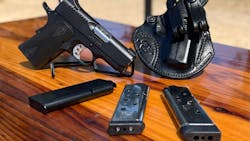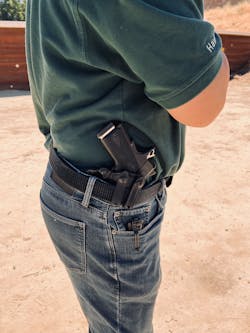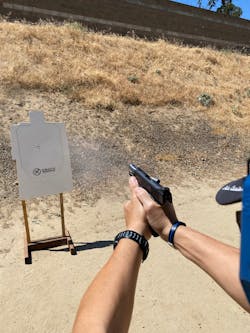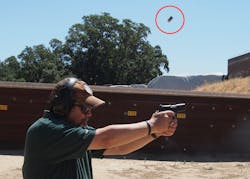Kimber Ultra Carry II Review
I tested Kimber’s Ultra Carry II in 45 ACP. This is a short grip, aluminum framed 1911 style gun, with a 3” bull barrel. At 25 oz, it is a good gun for EDC.
The Ultra Carry II is aluminum framed gun, with a stainless slide. It has the typical dimensions of a 1911, only chopped, so it can be carried discreetly. For many of us, the grip angle of this gun feels much better, and points much quicker, than most other guns on the market. Many shooters can shoot this gun quicker and more accurately than current polymer production guns.
This article appeared in the September issue of OFFICER Magazine. Click Here to view the digital edition. Click Here to subscribe to OFFICER Magazine.
Typical of most “officer-style” .45s, it has a skeletonized combat style hammer, and a three-hole, skeletonized aluminum trigger. The trigger was crisp and smooth, with a short take up. For a combat trigger on a duty gun, it was perfect.Currently, most law enforcement officers are using some variation of striker-fired polymer guns with trigger safeties. There are some duty firearm trends on the rise, however. One of them is an increase of agencies who have adopted the Staccato 2011 for duty. Some agencies are realizing that a single action gun with an external safety yields better qualification scores and a higher degree of safety for the public. For agencies whose officers carry a single action on duty, the Ultra Carry II is a good off-duty choice
The Ultra Carry II uses traditional single stack 7-round magazines. For those who are concerned about the “low capacity” of these guns, I generally carried 3 to 4 magazines off duty. They are flat, and there are plenty of flat magazine belt pouch products out there, but I just shoved them in my pockets. I also found that this Kimber, along with most other 1911 guns, allow the user much faster magazine changes, because of the ergonomics and slick sides of the mags.
Kimber let me try out some of their KimPro Tac-Mags, which come with Teflon coated stainless followers and quick-change floorplates. Users can choose the length of bumpers, just by attaching the desired ones with the included screws. These magazines have a smoother exterior and they fly out of the gun when the mag release is pressed. I recommend using these in all 1911 guns.
Both the front and rear sights are low profile style, seated in dovetails. The rear sight also has a set screw. The sights take advantage of the full length of the slide, giving a 4.8” radius. They are 3-dot style, and we found them extremely easy to acquire quickly. Our testing team member Robert Marvulli, who normally is behind the camera while I’m testing, is a regular 1911 user, and he was at home with the Ultra Carry II. Retired SRO Rick Macchia picked it up for the first time, and proceeded to shoot head shots with it. We all liked the sights.
The Ultra Carry II has a dual captured spring assembly, that has a smaller front bushing that only captures the recoil spring. Users familiar with a classic 1911 are accustomed to a front bushing that rotates to secure the barrel, and locks, using the recoil spring has a front detent. This is similar, with a dual captive recoil spring, and no front barrel bushing.
The Ultra Carry II has a beefy barrel with front lugs, in addition to the typical rear lugs. It also has a floating barrel link, similar to classic 1911s. Rick Macchia is a gunsmith, and he spent a little time inspecting the lockup. This gun is precision fitted, and the action is butter smooth
The slide has rear cocking serrations only, and the mainspring housing, which appears to be aluminum, has 30 LPI checkering.
The instruction manual that came with the Ultra Carry II is one that covers most of their 1911 models, as well as most 1911 guns in the world. It does not have much in the way of directing the neophyte how to take down the ones with a captive recoil spring.The user is supposed to slightly compress the recoil spring by pulling the slide back, then insert the supplied L-shaped tool, which is a thin wire that looks like an Allen wrench, into a hole in the guide rod. The tool keeps the spring compressed, aiding in the disassembly. Once the user has done this once, the Ultra Carry II field strip is a simple operation.
It was not until later that I discovered that field stripping is much easier when one compresses the spring prior to field stripping. If you are wondering, I managed to field strip this gun with an uncompressed spring a couple of times.
The Ultra Carry II has a grip safety, which prevents the gun from firing unless it is depressed. Typical of this design, it adds an extra margin of safety to the operating system, even though the parent design is over a century old. The modern adaptation also will prevent the slide from exiting the frame when disassembling the gun, so remember to avoid pressing the safety when field stripping.
I discovered the NDZ Performance Short Tear Down Tool in an internet search, and it looks like it would help the takedown of this gun tremendously. This is a Delrin insert that acts as a spacer between the guide rod and the end of the captive spring, holding the spring compressed enough for easy disassembly. This is much better than potentially marring the guide rod itself with the L shaped tool.
Kimber sent me a De Santis Cozy Partner holster to try with this gun, and it is worth mentioning here. This is a leather IWB sheath that is custom molded for the gun, and, if the user purchases it from Kimber, it can have the tooled Kimber logo on it. The Cozy Partner has a memory band on the mouth of the holster, which allows for one-handed reholstering.
The Ultra Carry II rides discreetly in this holster, and it is comfortable enough for all day wear. It has a split belt loop, which works well for dress pants that have belt loops right at the 3 o’clock position. The one feature of the Cozy Partner is the fact that it does work in both dress pants, for investigations unit assignments, and jeans, when the officer is assigned to Gang Suppression.
At 1.28” at its widest point, the Ultra Carry II is thinner than most compact guns, including the Glock 19. This is one of the reasons why many like to IWB this gun. Coupled with the thin magazines and a weight of only 25 oz, the Ultra Carry II is an easy gun to tote around for something that makes big holes.I’m not a big fan of synthetic scales on a 1911. They felt great, but a Kimber handgun is both functional and great looking. The next time I take an Ultra Carry II out for a spin, it will be with a Stainless Ultra Carry II (Product #: 3200330), which is the same gun, only prettier. I will add fancy wooden scales, and 30 LPI front checkering. The whole attraction to any Kimber is the pride in ownership of a beautiful gun. The gun we tested is a dull black-on-black gun with no frills. It shot extremely well, but I would prefer a satin finish or a two tone—not because they will shoot better, but because they are pretty.
I did some testing with my reloads and Winchester 230 grain FMJ ammo, both of which fed and shot flawlessly.
230 grain ammo is roughly twice as heavy as 9mm ammo. One would think that it would be much harder to shoot. Not only was it easy to shoot, but it was easy to print small groups at 20 yards. I shoot my EDC guns several times a month. I shot this gun only a few times. Any one of my testing team could have carried this gun with confidence
Most 1911 users enjoy a trigger that is unaffected by the other activities of the gun. Many striker-fired triggers are partially cocked by the action. The Ultra Carry II trigger just drops the hammer on the firing pin. Few striker guns can mimic this “feel,” and Kimber triggers feel better than most.
The Kimber Ultra Carry II was easy to shoot, and it sent large, heavy, bullets onto the target accurately. I recommend only one thing: Get the two-tone Ultra Carry II. It’s prettier.
This article appeared in the September issue of OFFICER Magazine.
About the Author

Officer Lindsey Bertomen (ret.), Contributing Editor
Lindsey Bertomen is a retired police officer and retired military small arms trainer. He teaches criminal justice at Hartnell College in Salinas, California, where serves as a POST administrator and firearms instructor. He also teaches civilian firearms classes, enjoys fly fishing, martial arts, and mountain biking. His articles have appeared in print and online for over two decades.



